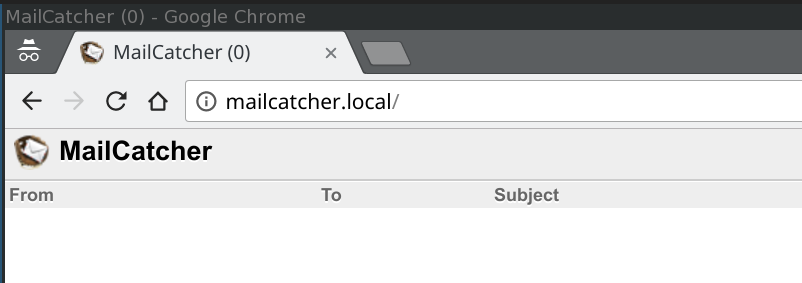This Docker images provides the schickling/mailcatcher image as base with the mDNS/ZeroConf stack on top. So you can enjoy the great mailcatcher app, which is accessible by default as mailcatcher.local.
- Requirements
- Getting starting
- docker-compose usage example
- Host configs
- Configure a different mDNS hostname
- Other top level domains
- How it looks
- Further reading
- Host enabled Avahi daemon
- Host enabled mDNS NSS lookup
You just need to run it like that, to get a working mailcatcher:
$ docker run --rm hausgold/mailcatcherThe port 1080 is proxied by haproxy to port 80 to make mailcatcher.local directly accessible. The port 1025 is untouched.
mailcatcher:
image: hausgold/mailcatcher
environment:
# Mind the .local suffix
- MDNS_HOSTNAME=mailcatcher.test.local
ports:
# The ports are just for you to know when configure your
# container links, on depended containers
- "1025"
- "1080"Install the nss-mdns package, enable and start the avahi-daemon.service. Then, edit the file /etc/nsswitch.conf and change the hosts line like this:
hosts: ... mdns4_minimal [NOTFOUND=return] resolve [!UNAVAIL=return] dns ...The magic environment variable is MDNS_HOSTNAME. Just pass it like that to your docker run command:
$ docker run --rm -e MDNS_HOSTNAME=something.else.local hausgold/mailcatcherThis will result in something.else.local.
You can also configure multiple aliases (CNAME's) for your container by passing the MDNS_CNAMES environment variable. It will register all the comma separated domains as aliases for the container, next to the regular mDNS hostname.
$ docker run --rm \
-e MDNS_HOSTNAME=something.else.local \
-e MDNS_CNAMES=nothing.else.local,special.local \
hausgold/mailcatcherThis will result in something.else.local, nothing.else.local and special.local.
By default .local is the default mDNS top level domain. This images does not force you to use it. But if you do not use the default .local top level domain, you need to configure your host avahi to accept it.
- Docker/mDNS demo: https://github.com/Jack12816/docker-mdns
- Archlinux howto: https://wiki.archlinux.org/index.php/avahi
- Ubuntu/Debian howto: https://wiki.ubuntuusers.de/Avahi/



